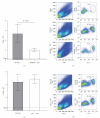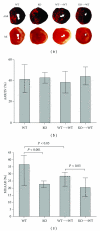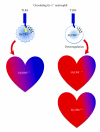Toll-like receptors and myocardial inflammation
- PMID: 21977329
- PMCID: PMC3182762
- DOI: 10.4061/2011/170352
Toll-like receptors and myocardial inflammation
Abstract
Toll-like receptors (TLRs) are a member of the innate immune system. TLRs detect invading pathogens through the pathogen-associated molecular patterns (PAMPs) recognition and play an essential role in the host defense. TLRs can also sense a large number of endogenous molecules with the damage-associated molecular patterns (DAMPs) that are produced under various injurious conditions. Animal studies of the last decade have demonstrated that TLR signaling contributes to the pathogenesis of the critical cardiac conditions, where myocardial inflammation plays a prominent role, such as ischemic myocardial injury, myocarditis, and septic cardiomyopathy. This paper reviews the animal data on (1) TLRs, TLR ligands, and the signal transduction system and (2) the important role of TLR signaling in these critical cardiac conditions.
Figures






Similar articles
-
Toll-like Receptors: Therapeutic Potential in Life Threatening Diseases- Cardiac Disorders.Cardiovasc Hematol Disord Drug Targets. 2024;24(3):125-133. doi: 10.2174/011871529X348433240915133309. Cardiovasc Hematol Disord Drug Targets. 2024. PMID: 39318220 Review.
-
Acute kidney injury: what part do toll-like receptors play?Int J Nephrol Renovasc Dis. 2014 Jun 19;7:241-51. doi: 10.2147/IJNRD.S37891. eCollection 2014. Int J Nephrol Renovasc Dis. 2014. PMID: 24971030 Free PMC article. Review.
-
Toll-like receptor signaling: a critical modulator of cell survival and ischemic injury in the heart.Am J Physiol Heart Circ Physiol. 2009 Jan;296(1):H1-12. doi: 10.1152/ajpheart.00995.2008. Epub 2008 Nov 14. Am J Physiol Heart Circ Physiol. 2009. PMID: 19011041 Free PMC article. Review.
-
The Intriguing Role of TLR Accessory Molecules in Cardiovascular Health and Disease.Front Cardiovasc Med. 2022 Feb 14;9:820962. doi: 10.3389/fcvm.2022.820962. eCollection 2022. Front Cardiovasc Med. 2022. PMID: 35237675 Free PMC article. Review.
-
Toll-like receptors in hepatic ischemia/reperfusion and transplantation.Gastroenterol Res Pract. 2010;2010:537263. doi: 10.1155/2010/537263. Epub 2010 Aug 5. Gastroenterol Res Pract. 2010. PMID: 20811615 Free PMC article.
Cited by
-
Functional Mechanisms of Dietary Crocin Protection in Cardiovascular Models under Oxidative Stress.Pharmaceutics. 2024 Jun 21;16(7):840. doi: 10.3390/pharmaceutics16070840. Pharmaceutics. 2024. PMID: 39065537 Free PMC article.
-
Association of toll-like receptors single nucleotide polymorphisms with HBV and HCV infection: research status.PeerJ. 2022 Apr 19;10:e13335. doi: 10.7717/peerj.13335. eCollection 2022. PeerJ. 2022. PMID: 35462764 Free PMC article.
-
The secretome as a biomarker and functional agent in heart failure.J Cardiovasc Aging. 2023 Jul;3(3):27. doi: 10.20517/jca.2023.15. Epub 2023 Jun 9. J Cardiovasc Aging. 2023. PMID: 37484982 Free PMC article.
-
Receptor for activated C kinase 1 in rats with ischemia-reperfusion injury: intravenous versus inhalation anaesthetic agents.Int J Med Sci. 2018 Feb 12;15(4):352-358. doi: 10.7150/ijms.22591. eCollection 2018. Int J Med Sci. 2018. PMID: 29511370 Free PMC article.
-
Role of cardiac- and myeloid-MyD88 signaling in endotoxin shock: a study with tissue-specific deletion models.Anesthesiology. 2014 Dec;121(6):1258-69. doi: 10.1097/ALN.0000000000000398. Anesthesiology. 2014. PMID: 25089642 Free PMC article.
References
-
- Akira S, Uematsu S, Takeuchi O. Pathogen recognition and innate immunity. Cell. 2006;124(4):783–801. - PubMed
-
- Kawai T, Akira S. The role of pattern-recognition receptors in innate immunity: update on toll-like receptors. Nature Immunology. 2010;11(5):373–384. - PubMed
-
- Michelsen KS, Arditi M. Toll-like receptor signaling and atherosclerosis. Current Opinion in Hematology. 2006;13(3):163–168. - PubMed
Grants and funding
LinkOut - more resources
Full Text Sources
Other Literature Sources

